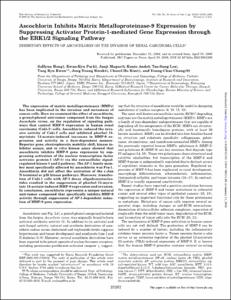Ascochlorin Inhibits Matrix Metalloproteinase-9 Expression by Suppressing Activator Protein-1-mediated Gene Expression through the ERK1/2 Signaling Pathway
- Alternative Author(s)
- Kwon, Taeg Kyu; Lee, Tae Sung; Park, Kwan Kyu
- Journal Title
- Journal of Biological Chemistry
- ISSN
- 0021-9258
- Issued Date
- 2005
- Abstract
- The expression of matrix metalloproteinases (MMPs) has been implicated in the invasion and metastasis of cancer cells. Here we examined the effect of ascochlorin, a prenyl-phenol anti-tumor compound from the fungus Ascochyta viciae, on the regulation of signaling pathways that control MMP-9 expression in human renal carcinoma (Caki-1) cells. Ascochlorin reduced the invasive activity of Caki-1 cells and inhibited phorbol 12-myristate 13-acetate-induced increases in MMP-9 expression and activity in a dose-dependent manner. Reporter gene, electrophoretic mobility shift, kinase inhibitor assays, and in vitro kinase assay showed that ascochlorin inhibits MMP-9 gene expression by suppressing activation of the nuclear transcription factor activator protein-1 (AP-1) via the extracellular signal-regulated kinase 1 and 2 pathway. The AP-1 family member most specifically affected by ascochlorin was Fra-1. Ascochlorin did not affect the activation of the c-Jun N-terminal or p38 kinase pathways. Moreover, transfection of Caki-1 cells with AP-1 decoy oligodeoxynucleotides resulted in the suppression of phorbol 12-myristate 13-acetate-induced MMP-9 expression and invasion. In conclusion, ascochlorin represents a unique natural anti-tumor compound that specifically inhibits MMP-9 activity through suppression of AP-1-dependent induction of MMP-9 gene expression.
Previous Section
Next Section
Ascochlorin (see Fig. 1A), a prenyl-phenol compound isolated from the fungus, Ascochyta viciae, was originally found to have antiviral antibiotic activity (1). In addition to its antiviral and anti-fungal activity, natural and synthetic derivatives of ascochlorin reduce serum cholesterol and triglyceride levels suppress hypertension and tumor development and ameliorate type I and II diabetes (2-9). Moreover, several ascochlorin derivatives have been reported to be potent agonists of nuclear hormone receptors, including peroxisome proliferator-activated receptor γ, suggesting that the structure of ascochlorin would be useful in designing modulators of nuclear receptors (6, 10, 11, 13).
The most well known extracellular matrix (ECM)1-degrading enzymes are the matrix metalloproteinases (MMPs). MMPs are a family of zinc-dependent endoproteinases that are capable of degrading all the components of the ECM. MMPs are structurally and functionally homologous proteins, with at least 20 known members. MMPs can be divided into four families based on structure and substrate specificity: collagenases, gelatinases, stromelysins, and membrane-associated MMPs. Among the previously reported human MMPs, gelatinase-A (MMP-2) and gelatinase-B (MMP-9) are key enzymes that degrade type IV collagen (14, 15). These two gelatinases share structural and catalytic similarities, but transcription of the MMP-2 and MMP-9 genes is independently regulated due to distinct arrays of regulatory elements in the gene promoters. Regulated expression of MMP-9 has been implicated in renal development, macrophage differentiation, atherosclerosis, inflammation, rheumatoid arthritis, and tumor invasion (16-17). In contrast, MMP-2 is usually expressed constitutively.
Recent studies have reported a positive correlation between the expression of MMP-9 and tumor metastasis in colorectal cancer and several other types of epithelial cancers (18, 19), suggesting an important functional role for these proteinases in metastasis. Metastasis of cancer cells requires several sequential steps, including changes in cell-ECM interactions, dissociation of intercellular adhesion complexes, separation of single cells from the solid tumor mass, degradation of the ECM, and locomotion of tumor cells into the ECM (20, 21).
The mechanisms of MMP-9 gene activation in human cancer cells are not well defined. The production of MMP-9 can be induced by a number of factors, including the inflammatory cytokine tumor necrosis factor-α. Tumor necrosis factor-α also serves as an autocrine regulator of the phorbol 12-myristate 13-acetate (PMA)-induced expression of MMP-9. It is known that the human MMP-9 promoter contains several cis-acting regulatory elements that participate in the regulation of the MMP-9 gene expression, including sites that bind the transcription factors AP-1 (located at -79 and -533 bp), NF-κB (-600 bp), and Sp1 (-588 bp) (22, 23).
We hypothesized that the anti-tumor and anti-metastatic activity of ASC may function to regulate MMP-9 in renal diseases. Renal cell carcinoma is a common renal malignancy, and no specific therapy presently is available for treating advanced renal cell carcinoma or tumor recurrence. It has been shown that MMP-9 expression correlates with invasion and metastasis of renal carcinoma cells, but the mechanisms regulating expression in this and other tumors are poorly understood (24, 25). Because early diagnosis of renal cell carcinoma would enhance treatment, we are interested in the expression and activity of markers like MMPs for the detection and treatment of renal cell carcinoma. In the studies described here, a human renal carcinoma cell line (Caki-1) was used to investigate the pathways that regulate MMP-9 expression. When Caki-1 cells are stimulated by PMA, expression of MMPs, particularly MMP-9, is enhanced greatly. Here we describe the molecular mechanism by which ASC blocks expression of MMP-9 in Caki-1 cells.
- Department
- Dept. of Immunology (면역학)
Dept. of Obstetrics & Gynecology (산부인과학)
Dept. of Pathology (병리학)
- Publisher
- School of Medicine
- Citation
- SaHyun Hong et al. (2005). Ascochlorin Inhibits Matrix Metalloproteinase-9 Expression by Suppressing Activator Protein-1-mediated Gene Expression through the ERK1/2 Signaling Pathway. Journal of Biological Chemistry, 280(26), 25202–25209. doi: 10.1074/jbc.M413985200
- Type
- Article
- ISSN
- 0021-9258
- 파일 목록
-
-
Download
 oak-aaa-4483.pdf
기타 데이터 / 409.54 kB / Adobe PDF
oak-aaa-4483.pdf
기타 데이터 / 409.54 kB / Adobe PDF
-
Items in Repository are protected by copyright, with all rights reserved, unless otherwise indicated.